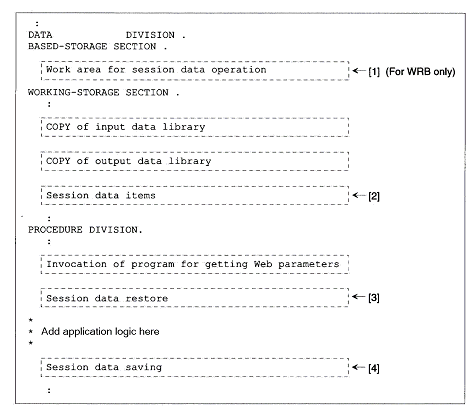Web application templates generated by the Web application wizard generally have the structure described in "Web Applications." The names and number of programs to be generated depend on the Web subroutine interface used. The following table lists the names that may be generated when using each Web subroutine:
API name | Program name | File name | Template |
|---|---|---|---|
CGI | exe-name-MAIN | exe-name-MAIN.COB | O |
ISAPI | GetExtensionVersion | dll-name-GetExtensionVersion.COB | |
HttpExtensionProc | dll-name-HttpExtensionProc.COB | O | |
TerminateExtension | dll-name-TerminateExtension.COB |
When ISAPI is used as the interface, the program name of the Web application is fixed. When another interface is used, an arbitrary program name can be used. Therefore, the execution file name specified by the wizard is replaced by "exe-name" or "dll-name" in the table above.
The program marked in the [Template] field in the table above has the structure described in "Web Applications."
Note
If a blank or illegal character in COBOL user language is contained in the execution file name specified by the wizard, the character is removed.
Web application startup must be specified with the ACTION attribute in the FORM tag on the request page. For example, to start the Web application "SAMPLE.EXE" which uses the CGI interface, specify the following line:
<FORM METHOD="POST" ACTION="SAMPLE.EXE">When [Generate a HTML file] is selected at [Include in the project a request HTML page] on the wizard screen, the wizard generates descriptions appropriate for the interface to be used. Conversely, when [Includes an existing file] is selected, the ACTION attribute value must be modified as follows:
API name | Specification in ACTION attribute |
|---|---|
CGI | [url-name/]exe-file-name |
ISAPI | [url-name/]dll-file-name |
An application template generated by the Web application wizard has the structure described in "Web Applications." When [ISAPI] is selected as the API, a program to save and restore session data can also be generated.
When the [Generate code for saving session data] or [Generate code for restoring session data] checkbox is selected on the wizard screen, the related work data item templates and processing are generated as shown below.

The session data items generated at position [2] are a dummy group item with suffix "-SESSION-DATA." To actually validate the session data restore and save processing, the target data items must be defined as data items belonging to this group item. The session data restore and save processing generated at positions [3] and [4] invoke subroutines for controlling the session range. To control individual session ranges, modify the subroutine invoking processing as required.